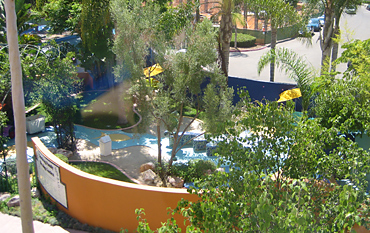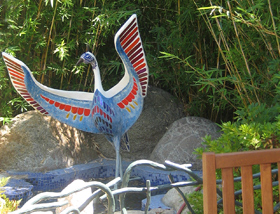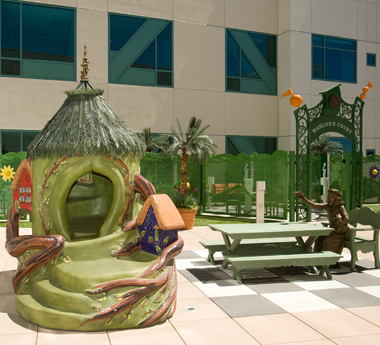Children and families need spaces that provide both respite and diversion. The beautiful gardens at our Hospital do just that, giving patients and their families a chance to relax, enjoy the outdoors, and take their minds off the medical care.
The Leichtag Family Healing Garden
The concept of this garden is rooted in our commitment to consistently nourish the physical, emotional, mental and spiritual needs of children, their families and our staff through our healing environment. Our wish is that when visitors leave the garden, they will feel strengthened and renewed.
We wanted the garden to be a place for the entire family, a refuge for them to get away from the stress of the high-tech environment of the Hospital. The theme of nature and art brings a peaceful feeling to all those who center. The design includes representations of the sky, earth, ocean and plants as well as all kinds of animals, symbolizing the beauty and hope of life.
The Garden features several unique creations developed by local and national artists. A 20-foot tall brontosaurus welcomes you at the entrance. The Constellation Wall lights up at night with all 12 signs of the zodiac. A windmill spins in the corner, and when the wind is strong enough, the colorful blades blur to a bright white.
Canopy benches are located throughout the Garden and can be wheeled to wherever you wish. In the late afternoon, the Shadow Wall casts images of animals on the teal, blue and green pavement. Beautiful ceramic tile creatures cover much of the walls.
The Leichtag Family Healing Garden is located on the western side of the Rose Pavilion.
Carley’s Magical Gardens
 Inspired by little Carley Jean Copley, who was just a toddler when her battle with leukemia came to an end, Carley’s Magical Gardens became an inspirational project to allow Carley’s spirit to live on. Carley’s parents, Elizabeth and Michael Copley, led fundraising and design efforts.
Inspired by little Carley Jean Copley, who was just a toddler when her battle with leukemia came to an end, Carley’s Magical Gardens became an inspirational project to allow Carley’s spirit to live on. Carley’s parents, Elizabeth and Michael Copley, led fundraising and design efforts.
Each garden has a theme and special elements to inspire hope and peace:
Garden of Dreams
Meandering walkways take visitors through a tropical garden setting. A large “hummingbird’s nest” made of colorful mosaic tiles is the centerpiece for the gardens and large sailcloth butterflies fly overhead. Standing on a large flat rock is a gentle bronze of Carley as she plays with one of her animal friends.
The Friendship Garden
A large maze-like playhouse inspires all visitors. With silly mirrors, a throne fit for a king or queen, and bronze sculptures hidden in secret cabinets, the playhouse allows children to imagine themselves in a magical land. A large gazebo provides partial shade for families to gather. Two bronze sculptures, Francisco and Henrietta the Rabbit, watch over the garden.
Carley’s Buggy Garden
Inspired by Carley’s love of bugs, the Buggy Garden includes a custom-built “Caterpillar Comfort Bench.” Fabricated from concrete, tile and metal, the colorful bench depicts a caterpillar with one wing emerging – symbolic of change and transformation. The garden also features “Carley’s Friends,” a collection of bronze bugs in seven different shapes.
Carley’s Magical Gardens at the Acute Care Pavilion
There are three Carley’s Magical Gardens at the Acute Care Pavilion:
Located just outside the main entrance, Rady Children’s Auxiliary Garden features bronze sea lions by palm trees and turtles sipping tea.
 Located just outside the Peckham Center for Cancer & Blood Disorders, on the second floor, is a whimsical, interactive garden specially constructed to lower the risk of infection from germs and mold; the grass is artificial but looks real. The garden features beautiful bronze sculptures and a tree house that includes a small track for children to race small Hot Wheels cars.
Located just outside the Peckham Center for Cancer & Blood Disorders, on the second floor, is a whimsical, interactive garden specially constructed to lower the risk of infection from germs and mold; the grass is artificial but looks real. The garden features beautiful bronze sculptures and a tree house that includes a small track for children to race small Hot Wheels cars.
Children can also crawl inside the tree house where a golden egg is hidden. Twelve golden eggs are hidden throughout the garden, and each contains a clue leading to the next egg. When the search is complete for all the eggs, the children can place a wish in the golden locket around the neck of a mosaic bird named Marisa. These wishes are then collected by staff to better understand the thoughts and needs of the patients.
Located on the third-floor terrace, at the south end of the building, is an interactive garden scene with bronze dogs, puppy sculptures, and sound elements.